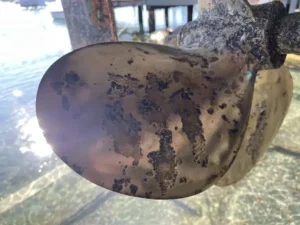A Simple Guide to Yacht Sacrificial Anodes
This guide covers the essentials of sacrificial anodes for yachts, including:
- What yacht anodes are
- Where to find them on a yacht
- Types of anode materials
- Key tips for anode use and care
- Galvanic corrosion basics
What Are Yacht Anodes?
A sacrificial anode is a protective piece of metal added to certain parts of a yacht to prevent corrosion. When a yacht’s metal components, like the propeller or shaft, are in contact with water, they can start to corrode. Anodes are designed to corrode first, protecting the more valuable parts of the yacht from damage. This sacrificial process stops corrosion from affecting essential parts, keeping them in better condition for longer.

Where to Find Anodes on a Yacht
Anodes are found on several parts of a yacht that are exposed to water, such as:
- Outboard engines
- Engine coolers and blocks
- Propeller shafts
- Trim tabs
- Rudders
- Sterndrives
- Metal struts in contact with water
- Exhaust parts
Newer yachts may have an anode connected to all key metal parts in a single, centralized location, usually at the back of the boat (transom).
Types of Anode Materials
Different anode materials are suited for different water types. The most common anode materials are:

- Zinc: Best for saltwater use. In brackish or freshwater, zinc may stop working, so it’s important to avoid it in those environments.
- Aluminum: A versatile choice that works in salt, brackish, and freshwater. It provides protection across different types of water, making it a good choice if you boat in mixed environments.
- Magnesium: Best for freshwater use only. In saltwater, magnesium corrodes very quickly, leaving your boat without protection.
Do’s and Don’ts for Using Yacht Anodes
For anodes to work well, they must be installed and maintained correctly. Here are some essential tips:

Don’ts:
- Don’t paint over an anode, as this stops it from working.
- Don’t paint parts of the yacht where an anode will be attached, as it reduces conductivity.
- Don’t add too many anodes, as this can lead to “overprotection,” which may wear away certain components faster.
Do’s:
- Ensure a secure connection between the anode and the part it’s protecting.
- Test wiring for any breaks to make sure all connections are intact.
- Replace anodes at each yearly maintenance check.
- If possible, inspect anodes every three months to check their condition, replacing them before they are fully depleted.
Pro Tip: If you buy a yacht or move to a new area, check anodes after one month in the new location. Different waters can affect the rate at which anodes wear down.

Understanding Galvanic Corrosion
Galvanic corrosion occurs when two different metals are in water, causing the less “noble” (weaker) metal to corrode faster. Sacrificial anodes are made of a less noble metal, allowing them to wear away first while protecting other, more critical parts of the yacht. This reaction is also called electrolysis and is why using the correct type of anode is so important.


